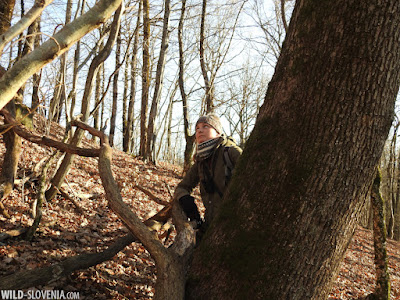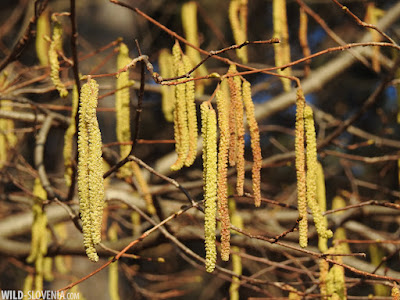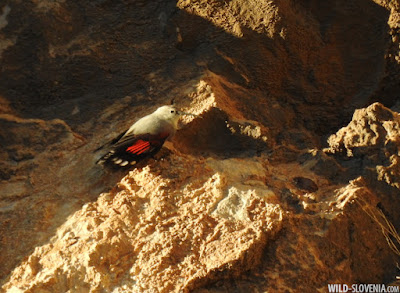
Despite being quite busy at work lately, we also managed to have some notable field outings here and there. This week I (Domen) helped my colleague Tomaž Mihelič (DOPPS-BirdLife Slovenia) catching a satellite-tagged Eagle Owl Bubo bubo in the Karst. The catch was successfull and the bird was released from its GPS rucksack, after it was carrying it for the past two years. Checking the state of the plumage for any signs of wear or damage from the shoulder straps, we were relieved to notice no signs at all. The bird was in good health and was immediately released, after the usual measurements. The data set gathered by the GPS device in the last two years, gave an extremely useful insight in the movements of this endangered species. In recent years Tomaž has already tagged several other Eagle Owls and the movement's data collected already helped adopting some efficient conservation measures, like isolation of medium-voltage power lines, which are the main cause of death (electrocution) in this species in Slovenia. With the male Eagle Owl singing in the calm night, Mistle Thrushes Turdus viscivorus delivering their melancholic song and a flock of Mute Swans Cygnus olor migrating overhead, it really felt like an early spring night in the Karst!
 |
Checking on the plumage for any signs of wear.
|
 |
Happy boys after a successful night.
|
 |
Eagle Owl Bubo bubo
|
Although the Karst looks rather birdless and empty in winter, the limestone cliffs of the Karst edge, just beneath the "karstic step", offer some excellent birding all-year-round. The warm sub-Mediterranean microclimate also makes birding very enjoyable on a sunny winter's day. The absolute highlight of this habitat is certainly represented by wintering Wallcreepers Tichodroma muraria. These birds breed in the Alps and in winter descend to lower elevations, especially in the Karst. During a recent visit to a limestone cliff we spotted not one but two birds, looking for food in the warm afternoon sunshine. One allowed quite close and good views - so good that we even saw it catching prey a couple of times. On a pinnacle up in the cliff, a vigilant Peregrine Falco peregrinus was looking down at us, while four Crag Martins Ptyonoprogne rupestris were circling in the sky. A few of the latter overwinter in the Karst, although this is a commoner species in spring and summer. We even watched a fly-by Sparrowhawk Accipiter nisus catching one of the local Rock Doves Columba livia from the cliff.
 |
Karstic kingdom (limstone cliff in the Karst edge).
|
 |
Wallcreeper Tichodroma muraria
|
 |
Shortly after catching an insect - looks like a bug (Hemiptera).
|
 |
Peregrine Falco peregrinus
|
The south-facing limestone cliffs are also the ideal place to spot the first signs of early spring. Even in the middle of winter it is possible to observe, sunbathing on the rocks, the Dalmatian Algyroides Algyroides nigropunctatus or the Common Wall Lizard Podarcis muralis, while the early-blooming flowers of Scorpion Senna Coronilla emerus are visited by the first bumblebees (we saw a Violet Carpenter Bee Xylocopa violacea) and the occasional Red Admiral Vanessa atalanta. Some of the cliffs along the Karst edge, apart from the endemic Tommasini's Sandwort Moehringia tommasinii (not yet in bloom), also host the attractive and rather localised Maidenhair Fern Adiantum capillus-veneris.
 |
| Dalmatian Algyroides Algyroides nigropunctatus |
 |
| Common Wall Lizard Podarcis muralis |

 |
Maidenhair Fern Adiantum capillus-veneris, mud-washed by a retreating karstic spring.
|
At this time of year also the oak woodlands on the Karst plateau look rather quiet at first. However, the good and persistent observer will still manage to find
interesting species with some dedication. Our ongoing fieldwork in this habitat involves measuring habitat parameters in the woodlands occupied by Middle Spotted Woodpecker Leiopicus medius, as part of Sara's study on the species. The mature
oak woodlands on the eastern edge of the
Karst are a stronghold for the Middle Spotted Woodpecker, which has
undergone a recent and
evident expansion in Slovenia (mostly post 2015). The species is a
mature forest specialist and lots of other woodpeckers
share the same habitat with it. Especially in winter, different species
like to stick together in loose flocks, searching for food in the same
patch of woodland. Usually when you come across a woodpecker or a Nuthatch Sitta europaea
there's a very high chance there will be several other species around.
Recently we found several Middle Spotted Woodpeckers rather casually, when
bumping into such roving flocks of woodland birds.


 |
Middle Spotted Woodpecker Leiopicus medius
|
Frequently, these winter roving flocks of birds also contain other woodpeckers, for example Lesser Spotted Dryobates minor and at least one or two Great Spotted Woodpeckers Dendrocopos major, sometimes feeding on the very same trees. On one occasion we also observed a Grey-headed Woodpecker Picus canus nearby, while Black Woodpecker Dryocopus martius
usually prefers to feed more on its own. Not surprisingly, all woodpeckers are
very
silent in winter and the only chance of finding them is by listening to
and following their pecking sounds on the trees. An interesting species
of the cooler oak-beech woodlands on the very edge of the Karst is also
the Treecreeper Certhia familiaris, usually more of a mountain bird in Slovenia (whereas Short-toed Treecreeper C. brachydactyla is the commoner species at lower elevations).
 |
Lesser Spotted Woodpecker Dryobates minor
|
 |
Grey-headed Woodpecker Picus canus (male).
|
 |
Mature oak woodland on the eastern edges of the Karst.
|
 |
Sara is perplexed by an elusive Middle Spot.
|
 |
Oak woodland on ex pasture with Bilberry Vaccinium myrtillus & Spring Heath Erica carnea.
|
 |
Low winter sun in the oak woodland.
|
When we are running out of time, usually in the short afternoons during the week, the woodland just behind our house comes in handy for short strolls. This site at km 0 is a mixture of karstic oak woodland (on limestone) and plantantions of Black Pine Pinus nigra. Still, like every local patch, if worked with perseverance, it can pay off. Lately, during a session of "jedi-woodpecker-hunting" (listening & following to barely-audible pecks on trees) we came across a female Grey-headed Woodpecker Picus canus, a rare species in our neighbourhood (of course we were rather excited). Also nice was the find of a male "Trumpeting" Bullfinch Pyrrhula pyrrhula ssp. pyrrhula, while more usual species include Short-toed Treecreeper Certhia brachydactyla, Crested Lophophanes cristatus & Coal Tits Periparus ater, Raven Corvus corax, as well as family parties of Wild Boar Sus scrofa and Roe Deer Capreolus capreolus. It is also rather nice to have the occasional Hawfinch Coccothraustes coccothraustes on the birdfeeder, which seems a rather scarce appearence in the garden this winter.
 |
Grey-headed Woodpecker Picus canus (female) in the wood behind the house.
|
 |
Short-toed Treecreeper Certhia brachydactyla
|
 |
Hawfinch Coccothraustes coccothraustes in the garden.
|
 |
Roe Deer Capreolus capreolus, behind the house.
|
 |
Oh, and sometimes also the dog needs to be taken out in the woods!
|
 |
Istrian Hellebore Helleborus multifidus ssp. istriacus - the first!
|
 |
Hazel Corylus avellana catkins
|
 |
Turkey Oaks Quercus cerris in the wood behind the house.
|
A rather good diversification to winter in the Karst is birding on the coast. Last weekend (15-16th January) we had the opportunity to check the sea coast properly, within the traditional International Waterbird Census (IWC) coordinated by DOPPS-BirdLife Slovenia. Apart from counting at Domen's usual work patch - Škocjanski zatok NR, we had to count on two coastal transects between Koper and Izola. On the bird front it was rather quite, but we were nevertheless really excited when we spotted a pod of around 15 Bottlenose Dolphins Tursiops truncatus putting on a show on the flat sea. We could watch them for at least one hour, although mostly through the scope, as they were slowly moving to the open sea. Thus, on this occasion, birds were only the "side dish". However there were still some species of note like 2 Black-throated Divers Gavia arctica, 3 Slavonian Grebes Podiceps auritus, a few Common Gulls Larus canus (scarce winter visitor in the last years), several Black-necked Grebes Podiceps nigricollis, Red-breasted Merganser Mergus serrator, Sandwich Tern Sterna sandvicensis and Kingfisher Alcedo atthis.
 |
Seawatching the Slovenian coast in the early morning.
|
 |
Bottlenose Dolphins Tursiops truncatus - pod of 15 individuals.
|
 |
Mediterranean Shag Phalacrocorax aristotelis ssp. desmarestii (adult with breeding crest).
|
 |
| Mediterranean Shag Phalacrocorax aristotelis ssp. desmarestii (juvenile). |
 |
Black-necked Grebe Podiceps nigricollis
|
 |
Sandwich Tern Sterna sandvicensis
|
 |
| Black-headed Gull Chroicocephalus ridibundus |
 |
Barrel Jellyfish Rhizostoma pulmo - the most abundant jellyfish in the Gulf of Trieste.
|
 |
A patch of Neptune Grass Posidonia oceanica - the species' only site in the Gulf of Trieste (near Koper).
|
 |
Mixed winter wildfowl at Škocjanski zatok NR.
|
 |
Snipe Gallinago gallinago
|
 |
Common Gull Larus canus (1st winter)
|



















































